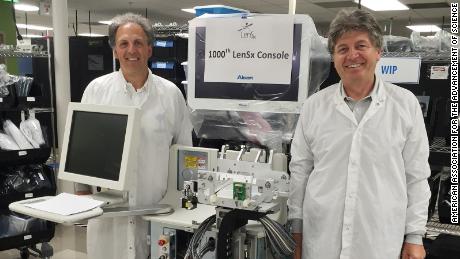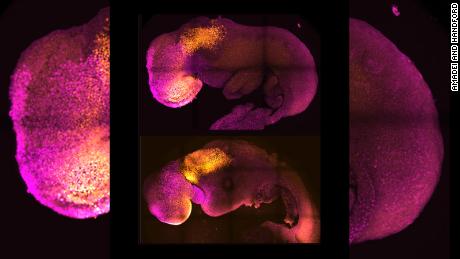
Three groups of scientists received 2022 Golden Goose Awards, a prize organized by the American Affiliation for the Development of Science, for his or her analysis tasks that morphed from “wait, what?” moments to pioneering breakthroughs.
“The Golden Goose Award reminds us that potential discoveries could possibly be hidden in each nook and illustrates the advantages of investing in primary analysis to propel innovation,” mentioned Sudip S. Parikh, chief govt officer at AAAS and govt writer of the Science household of journals.
Listed here are this yr’s award-winning discoveries, which illuminate the unpredictable path of science and the advantages of investing in analysis that may not instantly repay.
Greater than a decade in the past, Stanford College bioengineer Manu Prakash was within the Thai jungle on a discipline journey for his analysis into rabies when he had an thought for an inexpensive, easy-to-use microscope.
“I noticed this $50,000 microscope in a jungle in the midst of nowhere, locked in a room. It was an ironic second. I might see instantly it wasn’t the precise software,” mentioned Prakash, an affiliate professor and senior fellow on the college’s Woods Institute for the Setting.
Why was this important piece of scientific gear that might assist diagnose devastating illnesses like malaria sitting unused? It was cumbersome and awkward to transport, required coaching to function, and was tough to preserve. As delicate and costly because the instrument was, even skilled technicians may really feel nervous about utilizing it, Prakash defined.
Prakash imagined an affordable microscope that could possibly be utilized by anybody wherever however was highly effective sufficient to see a single bacterium. Alongside along with his colleague Jim Cybulski, Prakash got here up with the Foldscope — a flat-packed microscope made out of paper and a single ball lens.
“It took an immense quantity of engineering. In that earliest part, I used to be sat subsequent to labs with million-dollar microscopes. We wished to make a microscope at a worth level of $1.”
Folks initially thought the concept was a bit foolish, Prakash mentioned, and getting funding for the work was a problem.
Quick-forward to 2022. The Foldscope is not fairly as low-cost as a greenback, however at a price of $1.75 to make, it is a tiny fraction of the value level of most lab gear. The closing magnification of the telescope is about 140x, highly effective sufficient to see a malaria parasite in a cell. The devices have been deployed the world over in a dizzying array of functions. Final yr in India, the Foldscope was used to establish a brand new sort of cyanobacteria. The microscope has additionally helped to establish pretend medicine, Prakash mentioned.
Prakash mentioned Foldscope — and the broader premise of frugal science — has a much bigger position to play in a world awash with misinformation: “I would like to convey science into everybody’s palms. Make it extra private. Now we have decoupled on a regular basis life from the method of science.”

A facet hustle that remodeled neuroscience
As scientists working within the Philippines within the Nineteen Seventies, biochemists Baldomero Olivera and Lourdes Cruz, professor emeritus of the College of the Philippines Diliman, discovered it robust to pay money for the precise provides for DNA analysis.
“We had to discover one thing to do that did not require fancy gear as a result of we had none,” mentioned Olivera, a distinguished professor at The College of Utah’s Faculty of Organic Sciences, in a video produced for the Golden Goose awards.
Olivera and Cruz got here up with what they hoped could be a fruitful facet undertaking. Cone snails are commonplace within the Philippines, they usually had at all times fascinated Olivera, who had collected shells as a baby. The pair determined to analysis the character of the venom that the snails used to paralyze their tiny fish prey.
The crew found the bioactive compounds within the venom had been tiny proteins generally known as peptides. After shifting tothe US and teaming up with College of Utah grad college students Dr.Michael McIntosh and the late Craig T. Clark, Olivera and Cruz realized that among the venom peptides reacted in another way in mice than in fish and frogs. It turned out in mammals the compounds had been concerned within the sensation of ache, moderately than muscle paralysis.
“There was this unimaginable gold mine of compounds,” mentioned McIntosh within the video. He’s now a professor and director of analysis of psychiatry within the Faculty of Organic Sciences at The College of Utah.
Work on one sort of compound from the venoms, recognized omega-conotoxin, led to the event of a potent ache reliever, ziconotide, commercially generally known as Prialt.
Their work on conotoxins additionally remodeled neuroscience. Different scientists are nowexploring the potential for utilizing conotoxins to deal with a variety of diseases, together with dependancy, epilepsy and diabetes.
How a lab mishap led to a means to right imaginative and prescient
The most well-known lab mishap in science historical past, when mildew contaminated certainly one of Alexander Fleming’s petri dishes, led to the 1928 discovery of the primary antibiotic — penicillin.
A lot much less well-known is the lab accident that contributed to the event of LASIK, a laser process to right imaginative and prescient issues, together with near- and farsightedness. It is a process that has allowed tens of millions of individuals around the globe to ditch their glasses for good.
Within the early Nineties, Detao Du was a grad scholar on the College of Michigan within the lab of Gérard Mourou, a French physicist and professor. Morou, together with Canadian physicist Donna Strickland,developed an optical method that produces quick, intense laser pulses that can drill exact factors with out inflicting harm to the encompassing materials. This discovery earned Mourou and Strickland, a professor within the division of physics and astronomy on the College of Waterloo in Canada, the 2018 Nobel Prize in Physics.
One night whereas working within the lab, Du by accident lifted his goggles whereas aligning the mirrors of a femtosecond laser, then a really new sort of laser that emitted a particularly quick pulse of sunshine. Du’s eyeball caught a stray beam.
“He got here to my workplace very fearful. He was afraid they’d shut the lab,” mentioned Morou, who inspired Du to see a physician.
Du was handled by Dr. Ron Kurtz, then a medical scholar interning on the College of Michigan’s Kellogg Eye Heart.
“After we dilated the attention, what I noticed was a really small variety of very exact, what we might name, retinal burns within the very middle of his retina,” Kurtz mentioned in a video produced for the Golden Goose awards. “I used to be curious as to what sort of laser this was.”
Satisfied it might have a medical software, Kurtz met with Morou’s crew and ended up conducting analysis with Du, who had rapidly recovered from the harm. After a yr, they introduced their findings at anoptics convention in Toronto in 1994. There, they encountered and teamed up with a researcher who was already investigating lasers to right imaginative and prescient named Tibor Juhasz, then a analysis scientist on the College of California. By 1997, Kurtz and Juhasz based IntraLase, an organization that centered on commercializing the bladeless LASIK method for corrective eye surgical procedure.
Mourou mentioned he had by no means imagined that his precision laser would have functions past physics. He additionally credited the college management, who whereas insisting on higher security protocols, did not shut his lab as he had feared. As an alternative, the officers funded among the analysis that led to the corrective eye surgical procedure method.
“It took an accident like this to notice a brand new discipline,” mentioned Mourou, who added thatDu suffered no lasting results from his harm.






